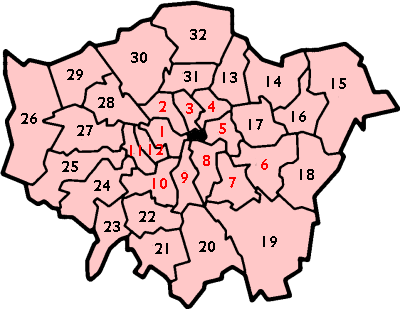Since 1965 Greater London, exclusive of the City of London, has been diviided into thirty-two London boroughs.[1] [2]
Formation[]
London boroughs were created by the London Government Act 1963, replacing the twenty-eight Metropolitan boroughs of the County of London and a number of county and municipal boroughs and urban districts in the surrounding counties of Essex, Hertfordshire, Kent, Middlesex and Surrey.[3]
Functions[]
London boroughs are are responsible for running most local services in their areas, such as schools, social services, waste collection and roads. Some London-wide services are run by the Greater London Authority. Some London borough councils also group together for such services as waste collection and disposal, e.g. the West London Waste Authority. Each London borough is a Local Education Authority. Until 1990 the twelve Inner London boroughs, covering the area of the former County of London, were not education authorities but were served by the Inner London Education Authority.
Governance[]
Each borough is governed by a London Borough Council. When created this consisted of elected councillors (with each borough divided into a number of wards returning three councillors each), aldermen (one for every six councillors, chosen by the council itself). The chairman of the council, chosen annually has the title of mayor. Elections of all councillors are held every four years, with casual vacancies filled by byelections.
In 1978 the office of alderman was abolished: although a council can confer the title of "honorary alderman" on a former member they do not form part of the council.
Under legislation introduced in 2000, boroughs may have a directly-elected mayor. This has been adopted in four boroughs: Hackney, Lewisham, Newham and Tower Hamlets. The chair of the council in these boroughs continues to perform the traditional ceremonial functions of a mayor, but with various titles.
Status[]
One borough: Westminster, has city status. This is a continuation of a status dating from 1540. Three of the boroughs are "royal boroughs": Kingston upon Thames (an ancient title confirmed in 1927), Kensington and Chelsea (originally granted to Kensington in 1901 as the birthplace of Queen Victoria) and Greenwich (granted to mark the Diamond Jubilee of Elizabeth II in 2012). The chairman of Westminster City Council has the title of "Lord Mayor".[4]
List of boroughs[]

Map of London boroughs
Inner London Boroughs
- Westminster
- Islington
- Camden
- Hackney
- Tower Hamlets
- Greenwich
- Lewisham
- Southwark
- Lambeth
- Wandsworth
- Hammersmith and Fulham
- Kensington and Chelsea
17. Newham
Outer London Boroughs
- Waltham Forest
- Redbridge
- Havering
- Barking and Dagenham
- (see inner)
- Bexley
- Bromley
- Croydon
- Sutton
- Merton
- Kingston upon Thames
- Richmond upon Thames
- Hounslow
- Hillingdon
- Ealing
- Brent
- Harrow
- Barnet
- Haringey
- Enfield
References[]
- ↑ London Local Government. London Councils.
- ↑ https://metro.co.uk/2021/04/06/how-many-boroughs-does-london-have-and-what-are-they-14343910/
- ↑ "London Government Bill. Fewer, Bigger, Boroughs To Run Own Education, Central Control Over Water". The Times. 23 1962.
- ↑ London Gazette: no. 43921. p. 2704. 11 March 1966. Retrieved 17 June 2008.